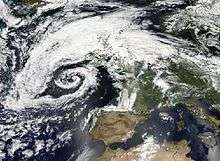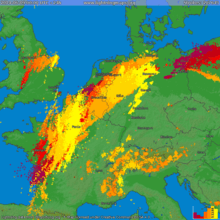Spanish plume

The Spanish Plume (Penacho Ibérico in Spanish and Spaanse Pluim in Dutch) is a weather pattern in which a plume of warm air moves from the Iberian plateau or the Sahara to northwest Europe giving rise to severe thunderstorms. This meteorological pattern can lead to extreme high temperatures and intense rainfall during the summer months, with potential for flash flooding, damaging hail storms and tornado formation.
Notable Occurrences
- 1788, 13 July, a hailstorm sweeps across France and the Dutch Republic with hailstones 'as big as quart bottles' that take 'three days to melt'; immense damage is done.[1]
- 1896, 10 September Paris Tornado.[2]
- 1897, 24 July saw thunderstorms disrupt the celebrations of Queen Victoria's Diamond Jubilee.[3]
- 1955, 18 July a Spanish Plume brought a record amount of rain on one day to Martinstown Dorset, with slow-moving thunderstorms bringing 279mm of rainfall.[4] A record which stood for over 50 years until the 2009 Cumbria floods.[5]
- 1958, 5 September Horsham storm, heaviest hailstone recorded in the UK (190g).[6]
- 1959, 9 July Wokingham storm.[6] the first in the world to be identified as a supercell.[7]
- 1961, 12 August synoptic set-up of a Spanish Plume, however dry ground conditions in France led to little evaporation which led to lack of moisture in the air to fuel cloud and storm formation.[6]
- 1968, 10 July Great Flood of 1968[8] Chew Stoke floods and Pforzheim tornado in Germany.[9]
- 1975, 14 July. Hailstorm in the Midlands.[10][11]
- 1983, 25-26 July. Three Mesoscale Convective Systems over West France with Severe thunderstorm, heavy rain and Hailstorm [12]
- 1985, 26 May East Anglia.[13]

- 1992, 20–21 July Severe thunderstorms over south-east England.[14]
- 1994, 24 June, Severe storms move from northern France and across south-eastern England.[15]
- 1995, 9 September A tornado was generated in the Rhine Valley, Germany.[9]
- 1996, 7 June damaging hail storms across England from Lyme Bay to the Wash.[16]
- 1997, 7 June A Bow echo formed over France before passing over Belgium and the Netherlands.[17]
- 2003, 5–6 August [18]
- 2011, 18 August a severe storm battered the Pukkelpop festival in Belgium. This situation shows some similarities with the Spanish Plume.[19]
- 2012, 10 May high temperatures reported in south of England with a tornado in Belgium reaching 100 mph gusts in Ghent.[20][21]
- 2012, 28 June supercells in UK and Belgium,[22][23] disrupted the 2012 Summer Olympics torch relay and brought chaos to North East England.[11][24][25]
- 2013, 26–27 July A Mesoscale convective system developed in France and moved across the Netherlands and northern Germany, a gust of 102 mph was recorded at Pauillac, France from the storm. Smaller scale thunderstorms developed in the UK.[26]
- 2014, 7–11 June Pentecost weekend storms in Europe brought disruptive conditions across France, Belgium and Germany where 6 fatalities were recorded as a Bow Echo swept through North Rhine-Westphalia with winds up to 144 km/h.[27][28]
- 2014, 17–21 July severe storms left at least two fatalities in France, with power cut to thousands of homes and localised flooding occurring in France and the United Kingdom.[29][30]
- 2015, 30 June–4 July A plume brought high temperatures from Spain across France and the UK. In France some July temperature records were set, and in the UK some all time maxima were set in some locations.[31][32] Severe thunderstorms also moved northwards across the UK on 1 July and again overnight 3–4 July.
Similar regional set-ups
Mexican Plume
A similar pattern, though on a larger scale, is the Mexican plume in the south west USA, where hot dry air from the Mexican highlands acts as a cap to convection until lifted over Texas, Arkansas and Oklahoma.[6][33][34]
Eastern Baltic
In Finland and the Baltic states meteorologists have observed a situation conducive to severe summer storm development which occurs when a warm moist air mass flows into the region from the south or south east under the influence of an upper-level trough. These conditions have some similarities to the Spanish plume.[35] The synoptic conditions see a low over southern Norway, bringing warm south and southwesterly flows of air up from the inner continental areas of Russia and Belarus.[36]
Animated descriptions of Spanish plume
- BBC Weather: Spanish Plume, what is it and how does it form with Darren Bett
- BBC Weather Player 'Spanish Plume' brings rain to the UK
Further reading
- Met Office: What is a Spanish Plume?
- Reigate Grammar School Weather Station: A beginners guide to the Spanish Plume!
- The Conversation, Explainer: how ‘Spanish plume’ set off a heatwave in the UK
- UK Weather Forecast: What is a ‘Spanish plume’
- Netweather Blog: The Spanish Plume Arrives & An Increasing Risk of Thunderstorms
- SkyWarn UK, Forecasting a Spanish Plume (June 2014)
- FMI Convective cloud features in typical synoptic environments: the Spanish plume
- FMI Convective cloud features in typical synoptic environments: the Spanish plume - Meteorological physical background
- FMI Convective cloud features in typical synoptic environments: the Spanish plume - Key parameters
- Estofex, Forecasting severe convective storms
- Morris, RM, 1986: The Spanish Plume - testing the forecaster's nerve. Meteorol. Mag, 115, 349-357.
- Categorisation of synoptic environments associated with mesoscale convective systems over the UK. Matthew Lewis and Suzanne L. Gray (2010) Atmospheric Research 97
References
- ↑ Stratton, J. M. (1969). Agricultural Records. London: John Baker. ISBN 0-212-97022-4.
- ↑ Mahieu, Pierre; Wesolek, Emmanuel (26 August 2011). "CONSEQUENCES OF TORNADIC STORMS IN URBAN AREAS:CASE STUDY OF THE PARIS TORNADO (FRANCE) IN SEPTEMBER 10,1896" (PDF). 6th European Conference on Severe Storms. 2011. Retrieved 5 June 2015.
- ↑ Webb, Jonathan D. C. (2012). "Severe thunderstorms disrupt the Diamond Jubilee on Midsummer Day 1897". Weather. 67 (7): 174–175. doi:10.1002/wea.1959. Retrieved 18 July 2014.
- ↑ Lee, John (10 August 2013). "Extreme weather in the UK". Meteogroup:Weathercast. Retrieved 12 August 2013.
- ↑ "Wild weather: Dorset's 1955 'record rainfall'?". BBC News. 10 September 2010. Retrieved 12 August 2013.
- 1 2 3 4 Carlson, T. N.; Ludlam, F. H. (1968). "Conditions for the occurrence of severe local storms". Tellus. XX: 203–226. doi:10.1111/j.2153-3490.1968.tb00364.x. Retrieved 5 November 2012.
- ↑ Browning, K.A.; F.H. Ludlum (Apr 1962). "Airflow in Convective Storms" (PDF). Quarterly Journal of the Royal Meteorological Society. 88 (376): 117–35. Bibcode:1962QJRMS..88..117B. doi:10.1002/qj.49708837602.
- ↑ "Spanish Plume". Meteogroup. Retrieved 3 November 2012.
- 1 2 Hannesen, Ronald; Nikolai Dotzek; Hermann Gysi; Klaus D. Beheng (1998). "Case study of a tornado in the Upper Rhine valley" (PDF). Meterologische Zeitschrift Berlin: 163–170. Retrieved 29 November 2012.
- ↑ Webb, Jonathan D. C. (2011). "The great summer heatwaves of 1975 and 1976 in the UK, and some violent storms". International Journal of Meteorology. 36: 255–261.
- 1 2 Clark, Matthew R.; Webb, Jonathan D. C. (November 2013). "A severe hailstorm across the English Midlands on 28 June 2012". Weather. 68 (11): 284–291. doi:10.1002/wea.2162.
- ↑ http://www.keraunos.org/orages-25-26-juillet-1983-derecho-mcs-macrorafales-charente-vienne-poitou.pdf
- ↑ Webb, J.D.C.; Elsom, D.M.; Reynolds, D.J. (January 2001). "Climatology of severe hailstorms in Great Britain". Atmospheric Research. 56 (1-4): 291–308. Bibcode:2001AtmRe..56..291W. doi:10.1016/S0169-8095(00)00081-8.
- ↑ McCallum, E.; Waters, A. J. (July 1993). "Severe thunderstorms over south-east England, 20/21 July 1992: Satellite and radar perspective of a mesoscale convective system". Weather. 48 (7): 198–208. Bibcode:1993Wthr...48..198M. doi:10.1002/j.1477-8696.1993.tb05886.x.
- ↑ Young, M. V. "Severe thunderstorms over south-east England on 24 June 1994: A forecasting perspective". Weather. 50 (7): 250–256. Bibcode:1995Wthr...50..250Y. doi:10.1002/j.1477-8696.1995.tb06121.x. Retrieved 17 July 2014.
- ↑ Webb, Jonathan D. C.; Pike, William S. (1998). "Thunderstorms and hail on 7 June 1996: An early season 'Spanish plume' event". Weather. 53 (8): 234–241. Bibcode:1998Wthr...53..234W. doi:10.1002/j.1477-8696.1998.tb06391.x.
- ↑ van Delden, A. "The synoptic setting of a thundery low and associated prefrontal squall line in western Europe". Meteorology and Atmospheric Physics. 65 (1-2): 113–131. Bibcode:1998MAP....65..113D. doi:10.1007/BF01030272.
- ↑ Holley, D. M.; Dorling, S. R.; Steele, C. J.; Earl, N. (November 2014). "A climatology of convective available potential energy in Great Britain". International Journal of Climatology. 34 (14): 3811–3824. Bibcode:2014IJCli..34.3811H. doi:10.1002/joc.3976. Retrieved 7 March 2015.
- ↑ "Pukkelpop storm, Chapter II: Description of the synoptic situation". EUMeTrain. Retrieved 18 February 2013.
- ↑ "Tornado richt ravage aan". De Standaard (in Dutch). 11 May 2012. Retrieved 29 November 2012.
- ↑ Demeyer, Paul (11 May 2012). "Spaanse pluim richt ravage aan". Nieuwsblad.be (in Dutch). Retrieved 1 December 2012.
- ↑ "From traffic cops to river patrol! Hosepipe bans become a distant memory as Britain has wettest spring since records began". Daily Mail. 29 June 2012. Retrieved 4 November 2012.
- ↑ "Surge Bulletin" (PDF). GAB Robins. July 2012. Retrieved 18 February 2013.
- ↑ "'Plume' blamed for freak weather". Orange News. 29 June 2012. Retrieved 18 December 2012.
- ↑ "Storms and plumes". MeteoGroup. Retrieved 18 December 2012.
- ↑ Penston, Seán (27 July 2013). "Heavy and thundery rain across Ireland and the UK". Meteogroup:Weathercast. Retrieved 30 July 2013.
- ↑ "Supercells over parts of France brought severe thunderstorms, large hail and flash flooding from 7–9 June.". EUMETSAT. 10 June 2014. Retrieved 10 June 2014.
- ↑ "Un week-end de Pentecôte marqué par une forte activité orageuse" (in French). Météo France. 10 June 2014. Retrieved 10 June 2014.
- ↑ "Lightning strikes and heavy rain over the weekend". Met Office. 21 July 2014. Retrieved 22 July 2014.
- ↑ Mills, Ian; Lancaster, Sancha (22 July 2014). "Very hot, moist conditions triggered thunderstorms and lightning over parts of Europe in mid-July.". EUMETSAT. Retrieved 22 July 2014.
- ↑ "Vague de chaleur : des températures record" (in French). Météo-France. 2 July 2015. Retrieved 2 July 2015.
- ↑ "2 July 2015 - Record breaking hot weather for July in the UK". Met Office. 2 July 2015. Retrieved 2 July 2015.
- ↑ "Oxford Index: Spanish Plume". Oxford University Press. Retrieved 29 November 2012.
- ↑ "Oxford Reference: Mexican plume". Oxford Reference. Retrieved 11 April 2013.
- ↑ Punkka, Ari-Juhani; Marja Bister (2005). "Occurrence of Summertime Convective Precipitation and Mesoscale Convective Systems in Finland during 2000–01". Monthly Weather Review. 133 (2): 362–373. Bibcode:2005MWRv..133..362P. doi:10.1175/MWR-2854.1. Retrieved 28 November 2012.
- ↑ Tuovinen, Jari-Petteri; Ari-Juhani Punkka; Jenni Rauhala; Harri Hohti; David M. Schultz (2008). "Climatology of Severe Hail in Finland: 1930–2006". Monthly Weather Review. 137: 2238–2249. Bibcode:2009MWRv..137.2238T. doi:10.1175/2008MWR2707.1. Retrieved 7 May 2013.